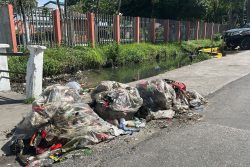On Tuesday President Ali announced that his government would be inviting expressions of interest from investors for the construction of a 30,000 barrels per day modular oil refinery.
Details of course appear vague as most announcements by this administration tend to be. However what is of immediate interest, is that it was the President himself who announced the initiative and not the Vice President, Guyana’s Oil Tsar.
What is propelling this proposal is President Ali’s emphasis on self-sufficiency which is a longstanding thread in Guyanese politics going back to The Burnham “Produce or Perish” times. It’s simplistic economics and seldom does more than create protected markets and higher prices for consumers. The Great Tomato Price Surge of August 2022 was ironically relieved by imported Brazilian ones. We are now seeing a pilot project to grow wheat here when it makes little agricultural or economic sense – simply a knee jerk reaction to the war in Ukraine and the doomsday headlines over global supplies that have not in fact materialised. Wheat prices have declined from $12.50 per bushel in May to $9.50 in early October.
The government is also subsidising the intermediate savannahs soybean project by building a $500M warehouse at Tacama to store soybeans and corn. Even with this gift, will the producers be able to grow the crops and process them more cheaply than neighbouring Brazil or the United States with their massive economies of scale? One doubts it, and this is about continuing the coddling of the powerful poultry industry by limiting imports of far cheaper foreign chicken. This means Guyanese pay four times more for legs and thighs than their American counterparts.
No country’s economy is an island entire upon itself. Guyana wants to be self-sufficient but cannot even manufacture a simple screw. And why would we when we can get it so much cheaper from China? This is the principle of modern trade. Countries produce what they are better at than others and import what they are not so good at. Guyana seems to have some comparative advantages in agriculture compared to the rest of the Caribbean but in general we have high costs due to slack management, low productivity, poor infrastructure and high electricity costs.
When it comes to refineries because of the large initial capital expense, scale is everything. A 2016 Bain and Co report forecast that the refineries which will survive over the next ten years are those large ones (over 300k b/d) in America, the Middle East and Asia close to large markets and shipping lanes and with access to a variety of quality crude oils.
In 2020 Alan Gelder, Wood Mackenzie’s Vice President of Refining, Chemicals & Oil said location was key, ideally with integration of nearby petrochemical industries. “Excellent logistics, integration with liquid biofuels and renewable power generation will give these facilities an edge.”
But on Tuesday Mr Ali announced the government would be looking at a small modular refinery (somewhere in Berbice probably) producing only 30,000 barrels of products per day which would likely not cover our projected domestic demand by 2030. Moreover modular refineries are wasteful as they do not produce the full spectrum of products from a particular crude. A ballpark figure to build one would be north of US$400M. A larger, more complex refinery which could also produce aviation fuel and bitumen would cost double that.
But let’s hear directly from an expert: Back in 2017 Pedro Haas, Director of Advisory Services at Hartree Partners had presented the findings of whether a refinery here would be viable. He concluded it was not. “Building and operating an oil refinery is risky and requires significant capital investment,” he told local businessmen.
He was also negative about a scaled down refinery. As reported by Stabroek News, he said:
“If you scale it down… If you have a very high infrastructural cost, the fact that you scaled down hurts the project instead of helping it. Because you are going to have to build docks, you are going to have to build tanks. You are going to have to build water treatment. You are going to have to build an energy facility to supply power. You are going to need steam. You are going to need all sort of ancillary facilities around the refinery to make the refinery viable. The problem you have with these massive investments is that the cost of building a refinery and the cost of building the infrastructure is not necessarily proportional. The bigger you build it the lower the unit cost,” he said.
Mr Haas added: “You can make various assumptions but we’ve made a range of assumptions and finally that gives you the cost of a grass-roots, 100,000 barrel per day, cracking refinery and we ended up with a total grass-roots cost in the neighbourhood of US$5 billion. It’s a large amount of money”.
According to the analysis, the base case for the 100,000 barrel-per-day new refinery would result in a negative rate of return to the tune of US$3 billion.
“Now that is a very significant number because if you remember the total investment is US$5 billion. That means you are destroying over half the value of your investment the day you commission your refinery. It’s a very significant value destruction impact and of course, the maximum debt leverage is very, very small,” he pointed out.
Now one might argue that this is a problem for private investors to deal with: If they want to embark on this folly it’s their money. But it is not as simple as that.
There are opportunity costs for the government and country too. Such a project requires expansive land far from residential areas, along the coast or a waterway and with a deep water harbour. There are really very few suitable locations. Is this then the best allocation of land for the country? There are also the demands on government resources, both financial and human, to regulate such mid-stream activity even as we are still low on the learning curve for upstream operations.
It is worth noting here that the Vice President has ruled out any refinery getting oil from one of the FPSOs at below market price. So exactly what is the economic advantage this small local refiner might have? Given the highly uncertain viability for such a small refinery one might expect investors to demand concessions such as peppercorn leasing of the land or no excise tax on the fuel produced. The former might end up being similar to what developed at Leonora where businessman Ed Ahmad was sold 17 acres for $80M, based on a proposal for a wood processing plant but ended up developing the land as houselots. The latter might ignite objections within Caricom over compliance with the Treaty of Chaguaramas.
As to what a refinery would do to Guyana’s environmental goals and its perception as a carbon sink it would be hard to tell but certainly not a move in the correct direction.
Ultimately it will come down to international banks and whether they see such a refinery being viable here. It is doubtful both economically and in the context of growing Environmental, Social, and Governance regulations. Finally if we want more evidence of why it is not a good idea, one can simply point to Trinidad whose 140,000 barrels per day Petrotrin refinery has been shuttered since 2020 having amassed US$2B in debt over the previous five years. Why would one, a fifth of the size, in a country with zero aligned industries make more sense? Once again what investors want is often not what is good for our country. The President would be wise to have a rethink. Instead of being driven by businessmen and their proposals, he should provide, after extensive consultations, a master plan for Guyana within which they would be allowed to invest and operate. Everything else is just Wild West.









